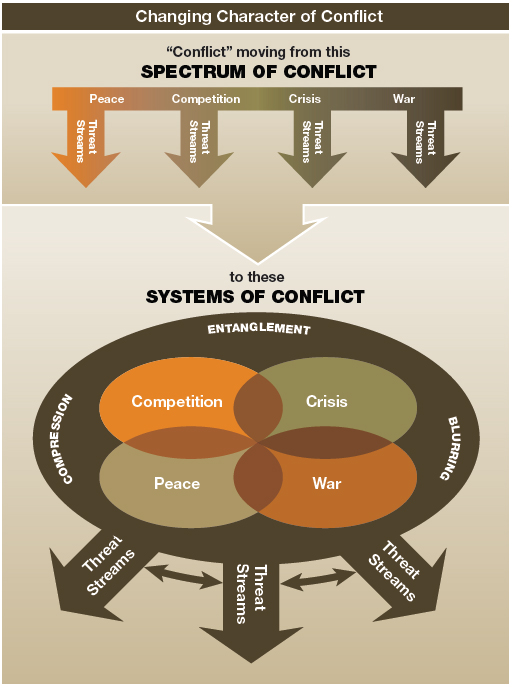Section 1: The Emerging has Emerged
The emergence of new forms of long-term strategic competition and a weakening of the international rules-based order are playing out on multiple fronts and across multiple dimensions of power. Economic coercion, influence operations, media manipulation, cyberattacks and the use of paramilitary and proxy forces are just some of the ways in which unfriendly actors are seeking to disrupt the status quo, often through blurred and ambiguous means and often while violating principles of sovereignty.
These developments can be expected to influence geopolitical dynamics, from migration patterns to liveability of coastal cities and from food security to access to natural resources, particularly as they intersect with growing and sometimes concerning trends such as increased technological speed with wider disruptive effect, global demographic growth, urbanization, and climate change. All of this will have significant implications for the defence of Canada and Canadian interests and the work of the Department of National Defence and the Canadian Armed Forces.
CANSOFCOM must therefore continuously track the myriad ways in which global trends and related events could play out, and stay on top of how these are expected to impact Canada from an economic, political, and security perspective. CANSOFCOM must be prepared to adapt its knowledge, skills, capabilities, relationships and business practices to these changing times.
CANSOFCOM must also be ready to respond to the most likely threats of the day. They include the increasing use of hybrid methods (i.e., the employment of all components of national power) in the “grey space” of conflict below the threshold of state-on-state warfare; the diminishing distinction between domestic and international threats; the continued influence of terrorist and violent extremist organizations; the growing complexity and ambiguity of conflict and competition; and the proliferation and use of weapons of mass destruction.
Additionally, CANSOFCOM must remain ready to enable the CAF in supporting conventional deterrence, by having the ability to convince a potential aggressor that the consequences of coercion or armed conflict would outweigh the potential gains.
Lastly, CANSOFCOM must be prepared to support the CAF’s ability to engage in warfighting, should all other options fail.
Figure 1

Figure 1: Long description
The character of conflict is changing. Conflict is moving from a spectrum, consisting of four threat streams (peace, competition, crisis and war) to systems of conflict in which the threat streams intersect and overlap. The strategic trends of compression, entanglement and blurring surround and shape these threat streams.
Such an unpredictable and dynamic environment will require CANSOFCOM to maintain persistent engagement with key partners and other actors around the globe. It will require CANSOFCOM to anticipate the impact of new technologies on its current capabilities as well as on future conflicts. And ultimately, CANSOFCOM will have to be proactive and scalable, while maintaining mandated readiness levels at all times.
Within this environment, conflict can no longer be considered solely a linear spectrum with “distinct frequencies” to which responses are dialed. Instead, it is becoming an entangled set of systems through which threats emerge at all levels, simultaneously and non-linearly.
Several strategic trends are shaping these systems of conflict.
Firstly, state-level conventional military conflict continues to be restrained by the deterrent threat of weapons of mass destruction and effective collective conventional deterrence. This, in turn, is leading adversarial state actors to rely more and more on grey space conflict, which falls at or below the threshold of what has traditionally constituted conventional armed conflict, in order to advance their interests while avoiding all-out warfare.
Secondly, the shift in global power dynamics is leading existing and emerging global powers to attempt to enfranchise previously ungoverned or minimally regulated spaces (such as outer space and cyberspace as well as physical territories). This trend points towards a likely future of fewer small, independent organic start-up insurgencies and more hybridized state-influenced proxies directed by great powers.
Thirdly, technology is empowering all actors within society. The power of the individual vis-à-vis the state is increasing, thanks to the impact of disruptive technologies and transformative tools, which is heightening the potential for tension between the “individual” and the “state.” The ability of individual citizens to access information, amplify their voices and connect in order to advance their causes has never been greater. Concurrently, yet conversely, the links between social structures and the political structures that govern them are mappable with a greater degree of resolution than ever before, allowing the state to identify and track individuals in ways that were previously impossible, to communicate its own messages to a wider audience, and to engage with its citizenry in real time across a range of issues. The consequences of the inevitable collision between these two factors remain unknown, contributing to ongoing uncertainty within the strategic environment for the near-to-mid-term future.
The convergence of these trends is blurring traditional lines of conflict and entangling the thresholds between conflict and competition. The limits of what can be accomplished in terms of damage to an opponent’s interest or promotion of one’s own, particularly in the context of grey space conflict, are not clearly understood. Moreover, both state and non-state actors continue to re-define the realm of “the possible.” This is putting increasing strain on the globally accepted sets of ideas, rules, and beliefs that have traditionally provided the foundation for the actions and decisions of states, rendering them less able to respond meaningfully.
Against this background, CANSOFCOM must be ready to respond to a wide assortment of evolving factors while at the same time be able to focus quickly on the most likely threats.